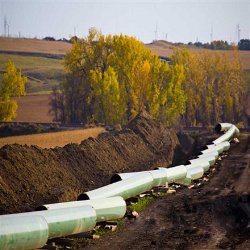Oklahoma’s Williams (NYSE: WMB) and Houston’s Boardwalk Pipeline Partners (NYSE: BWP) have teamed up to develop a new major natural gas pipeline, named the Bluegrass Pipeline, which would cut through Kentucky and connect gas fields underneath Pennsylvania to refineries and export markets on the Gulf Coast.
That means resources from the Marcellus Shale will now be accessible by facilities in Texas and Louisiana, which can then export them around the world. Kentucky.com reports that the pipeline, once completed, would allow for the initial transport of some 200,000 barrels of natural gas liquids per day from the shale operations in Pennsylvania, Ohio, and West Virginia over to the facilities along the Coast. This capacity would later be upgraded to 400,000 barrels per day, chiefly by the addition of liquids-pumping capacity.
The venture also means wholly new facilities, both along the pipeline’s route and in the South where it terminates, would be constructed and developed, the Pittsburgh Post-Gazette reports. Roughly 40 percent of the project proposal comprises new construction and development, and this is focused largely within the Marcellus region, though no exact locations have yet been decided upon.
 An interconnect in Kentucky would connect to origin points of the pipeline located in Ohio and West Virginia. Also in Kentucky, an existing system will partially be reconfigured to allow for the transportation of natural-gas liquids, Kentucky.com reports. The final route the pipeline will follow has not been determined yet.
An interconnect in Kentucky would connect to origin points of the pipeline located in Ohio and West Virginia. Also in Kentucky, an existing system will partially be reconfigured to allow for the transportation of natural-gas liquids, Kentucky.com reports. The final route the pipeline will follow has not been determined yet.
This project comes as the latest in a series of high-profile pipeline development efforts in and near the Marcellus Shale region, as companies try to exploit the lacking American pipeline infrastructure situation by building new networks that can handle the rush of shale-derived oil and natural gas (and related products), which the existing heavy crude pipelines cannot readily do.
In fact, the situation is so complex that some Marcellus and Utica shale producers have had to slow down their operations as they wait for the pipeline network infrastructure to play catch-up. But natural gas prices have dropped even further, so developers are showing more interest in liquids derived from natural gas, like condensate, ethane, and other natural-gas liquids, Kentucky.com reports, which could be sold in numerous markets both domestic and international.
According to Williams, the present system is likely to be under too much pressure as soon as 2016, with the total volume of natural-gas liquids being produced in the Northeast projected to go over 1.2 million barrels per day by 2020.
Kentucky.com quotes Williams President and CEO, Alan Armstrong:
“We are designing Bluegrass Pipeline to provide these two world-class resource plays with access to one of the largest and most dynamic petrochemical markets in the world,” Armstrong said. “This will help producers in Ohio, Pennsylvania and West Virginia achieve an attractive value for their ethane and other liquids.”
The way Boardwalk and Williams envision this project is for the pipeline to deliver mixed natural-gas liquids from the shale zones in Ohio, W. Virginia, and Pennsylvania to numerous fractionation plants and storage centers. These have yet to be built, but they will be positioned along the pipeline’s route. They would subsequently link up with petrochem plants and end-product pipelines along the Texas and Louisiana coasts.
Our analysts have traveled the world over, dedicated to finding the best and most profitable investments in the global energy markets. All you have to do to join our Energy and Capital investment community is sign up for the daily newsletter below.
No costs have been cited yet, as those are part of the details still being worked out. The problem of moving the shale derivatives out of the Northeast and nearer to the refineries and other facilities is one of the U.S. shale sector’s biggest issues, and this project will undoubtedly do its part in alleviating the pressure.
Roughly 60 percent of existing pipeline can be used, according to Kentucky.com; this is mostly owned by Boardwalk, named the Texas Gas Pipeline. New construction would simply expand on this network. It would allow the project to possibly come online by or in the second half of 2015, while also keeping construction costs down.
Boardwalk has nearly 1,420 miles of natural gas pipeline networking through Western Kentucky and employs 315 out of its 1,200 employees within that state.
Prior to this development, Enterprise Products Partners LLP and Chesapeake Energy (NYSE: CHK) came up with a similar plan in 2011 to develop a pipeline that would transport ethane from the Marcellus Shale region, connecting it to refineries and facilities along the Gulf Coast. More such projects will need to be developed before the Appalachian shale bottleneck can see some real relief.
If you liked this article, you may also enjoy:




